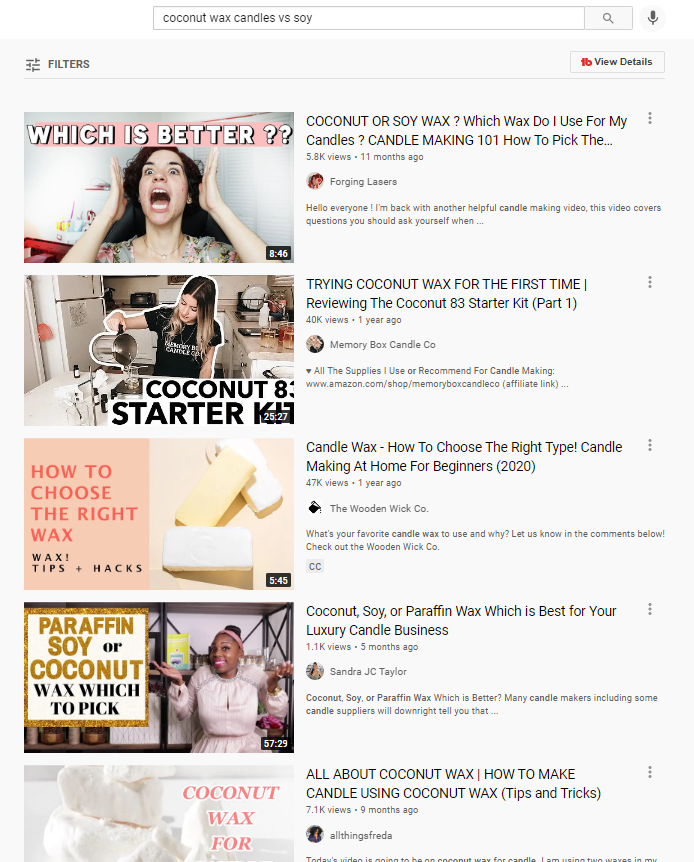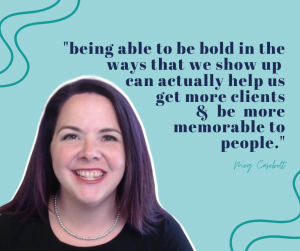Typically if someone tells you that you “stick out like a sore thumb”, you’re probably gonna start blushing and get über embarrassed.
I’m here to convince you that in order to get your content noticed, you’ve gotta be that sore thumb. (Notice how I dyed my hair bright purple? I couldn’t have given you a better example on how I make myself stand out from the rest).
With so many creators and brands using the same platforms as you, it can feel overwhelming when you’re figuring out ways to stand out. Although the internet is a crowded place and there are always going to be people trying to do the same things as you, there are ways to make sure that your content stands out.
how to stand out
Before you can think about making your content stand out, you have to stand out first.
be “just like me”
Research has shown that the second most important factor in somebody wanting to trust you and buy from you is feeling like they know you. People want to feel like they’re “just like you.”
So how do you make people relate to you? Talk about things that you like and just be you! By being authentic and talking about your everyday life, you’re portraying yourself as someone that people can relate to instead of just being another teacher or source of information on the internet (like everyone else is!)
Set yourself apart from the others and instead of exclusively talking about your content, talk about things like your hobbies, your interests, your family – that way people see you not just as a face but as a whole person who is just like you.
For example, I cater my content to entrepreneurs, especially women-owned small businesses. I talk about my family, my interests and hobbies, even recent things that have happened in my life. The reason I’m able to connect with my audience is because I share my own story and show up authentically me, and my audience connects with that.
Here are some things you can think about to get that personality to shine!
- what are your hobbies? what do you like to do in your free time?
- are you a cat or dog person? how many pets do you have?
- what’s a fun, random fact about you? what’s something about you that no one would typically guess by just looking at you?
- what’s your career journey been like? what roles and industries have you worked in?
- where are you from? where do you live? have you traveled anywhere cool?
- what’s your music taste? your favorite T.V. show or movie?
- what’s your family like? do you have kids?
- do you have a strong, defining personality trait?
It’s much easier to connect with someone who has shared or similar experiences than with someone who is completely different than you – it just makes sense!
Like they always say, people don’t buy products – they buy you.
be an expert
This one pretty much goes without saying. If you’re not confident in what you’re saying and doing, why are people going to keep coming back to you as a source of credible information?
(They probably won’t).
You have to position yourself as an authority figure. This could be as simple as switching up your phrasing to sound more confident.
If you’re in the social media marketing space, instead of saying, “try posting on social media more because it may help your business grow,”
try this: “you have to start posting on social media at least 3x a day to increase your engagement.”
See how simply using confident words instead of those wishy-washy phrases can instantly change the whole feel of what you’re trying to get across?
You don’t see me using these iffy phrases in my YouTube videos, because I want to make sure that I portray myself and my brand as confidently as I can so people come back to me when they wanna learn about SEO.
make google your best friend
Part of being an expert means being an expert on your target audience. Use Google to search for what you think people will search for!
Let’s say you’re a small candle business looking to create some content for your YouTube channel. Your brand prides itself on the fact that you only use coconut wax, but there are so many other brands out there that offer the same (or a similar) product as you.
You’re trying to come up with unique content that hasn’t really been done before.
So, go to Google and start searching for what you think your customers might search. You know that there’s a lot of talk about coconut candles vs. soy candles and conventional candles, so you search, “coconut candles vs soy ” and the following videos pop up:

Notice how all of the videos that pop up on the first page are about candle-making? There’s nothing for consumers – this is all for candle-making business owners.
Simply by doing a search of what you think your customers may be searching for, you now know that there is a huge opportunity to make some unique content.
A couple of video ideas could include talking about the benefits of burning coconut wax candles in your home, or why coconut wax candles are more sustainable than soy.
Now that you’ve got a better idea about how to make your content stand out, we gotta make sure you understand how to best optimize that content so that people will actually click on it.

make your content stand out
Getting people to engage with your content is a two-part process.
The first part is how the content shows up on the search engine results, and the second part is what content shows up on your website.
quit it with the boring headlines
Before anyone’s going to engage with your content, it has to be interesting enough to get them to click on it first.
How do you do that?
Include something to make yourself stand out in your SEO title and your meta description. This needs to give them a good idea of what they’ll get in the actual content (on your website).
One of my most popular blog posts is called “wtf is seo?” – how many boring names could I have chosen for this blog post that would’ve made people scroll right by it on their search engine results?
Like, “everything you need to know about seo” or “what is search engine optimization?”
Boring.
By calling it “wtf is seo?” I not only set myself apart in the sense that I don’t mind swearing on my blog posts, but I’m acknowledging that seo is a complicated topic and that’s okay to ask questions like that.
Then when you get to the meta description for the blog post, you want to give your readers an idea of what they can expect once they click through.
And remember how earlier we said to show your personality? You can do that here too. By integrating your personality and brand voice into the title and meta description, you’re going to get more qualified leads.
The people who click on your link are probably going to resonate with your personality instead of simply clicking on any random link that seems like it was written by a bot. Think about what you would click on if you were the one searching.
hook & connect them as soon as possible
Once you’ve shown up in the search engine results, it’s then up to your website to get those people to the next step by subscribing, following you on your socials, or even buying a product.
There are a few different ways you can get people to engage with your content once they’ve gotten to your website
Create an introduction that pulls the viewer in – this may be a personal story, an example of how you’ve helped a client with something, or even a statement validating why the reader is there.
This intro needs to let them know that they can trust you.
For example, take a look at the intro to my “seo for podcasts: how to optimize your show notes” blog post:

What three things did I do in this intro?
- Incorporated a personal story/anecdote
- Included an example of me working with multiple clients
- Validate why the reader clicked on this blog post by including commonly asked questions
lead the horse to water, and make ’em drink
Once people are on your site, you can give them two options:
1. Give them a way to go deeper
Simply put, you’ve gotta link to more things on your website that are related to what they found in the first place.
If you’re writing a blog post, link to something related to a topic in that blog post itself.
If you’re on YouTube, make sure to use cards to link to other related videos.
Not only will this get people to engage with even more of your content, but it will also get them to trust you and want to continue to learn from you as an expert on a particular topic.
2. Lead them to the next step
Now you’re at the point where you need to include a call to action.
Encourage them to join your newsletter. Link directly to related offers. Link directly to the ways they can book a call with you or purchase a product or sign up for a course.
It’s your content’s job to stand out from everyone else to draw people into your website ad then get them to the next step to convert into leads, subscribers, or sales.
If you follow these tips every time you create content, you should have no problem being that sore thumb.
